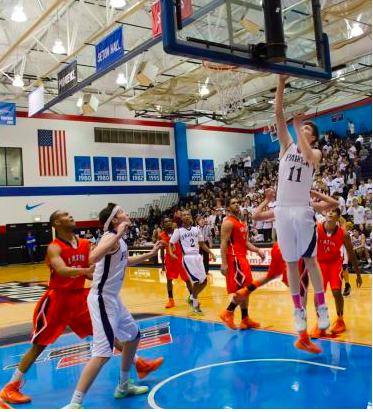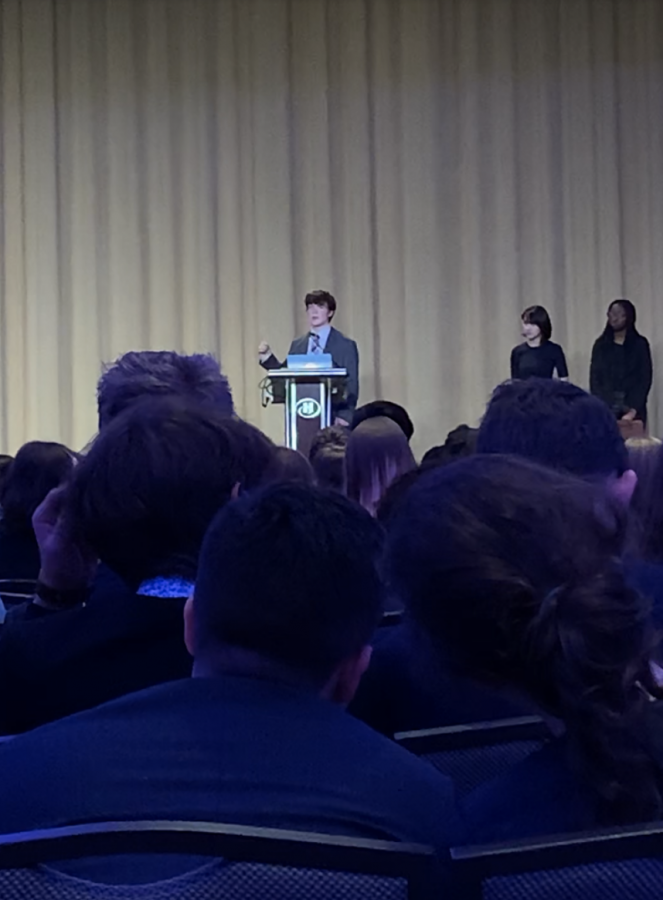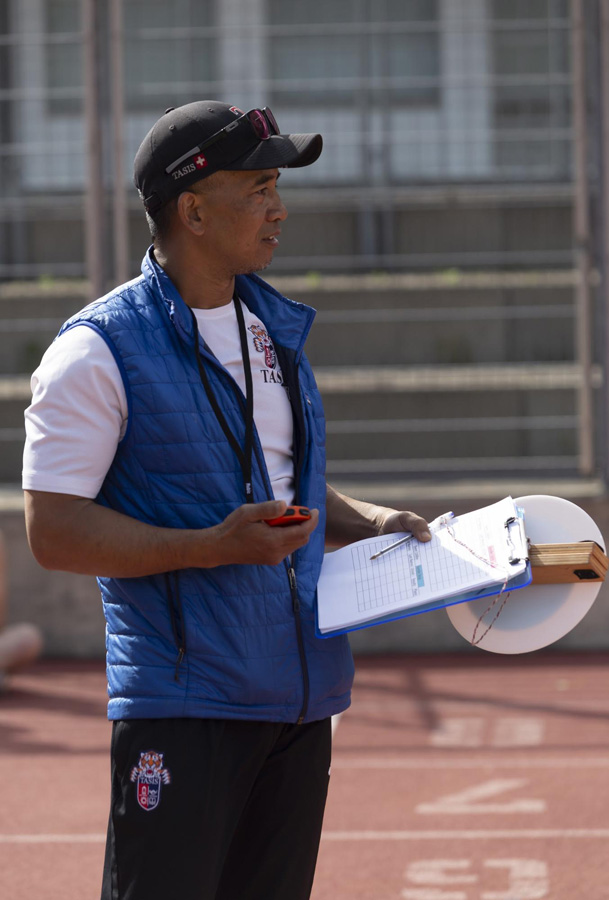 Michael Gross
Down 42-41 with 30 seconds left in the game, instead of playing it safe kicking the extra point and going into overtime, Michigan deciding to go for two and the win against their long-time rival, Ohio State. Devin Gardner drops back, passes the ball, INTERCEPTED! The Buckeyes escape with a win – a crushing blow for the Wolverines. A disappointing end to a disappointing season.
Tied with one second on the clock in the Iron Bowl, Alabama sends out its freshman kicker to attempt a 57 yard field goal for the win against their hated rivals, Auburn. The kick is up, but short – overtime, but wait, Auburn’s Cliff Davis catches the missed field goal, and starts down the field, first right, then left, running past all the Alabama defenders who just stare in awe at the back of his jersey – TOUCHDOWN! Auburn wins!
The buzzer sounds, that is it. 59-43 Parker, a final. Disappointing loss for the young and promising Latin Romans.
What is similar about the final seconds in each of these three sporting events? Not the excitement, of course, because the third scenario certainly does not fit that criteria. Rather, it’s what that makes sports so special: the culminating moments of much anticipated match ups between long standing rivals.
From a spectator’s point of view, the Latin vs. Parker Varsity boys basketball game last Friday night was the farthest thing from exciting, as Latin’s hopes to avenge their heartbreaking soccer defeat fell short to their bitter rival, Parker, in a game that many felt Latin lost rather than Parker won. After the heartbreaker, junior guard Brennan Besser said, “It was disappointing, of course, but it just makes us want to beat them even more in January.”
Aside from the games themselves, what makes rivalries so special? They create tradition – wearing the words “Latin” comes with 125 years of history, over 100 of which included fierce battles with Parker. Rivalries help build and sustain memories, as school spirit is channeled through the hatred of the other side. At Latin-Parker events, students who you couldn’t even imagine being affiliated with a particular sport come out to cheer on their school. There is a certain sense of obligation one feels when involved in the rivalry – an unwritten contract they sign by entering the school. At the games, it is Parker vs. Latin, nothing else – all the cliques that divide up the student body seem to disappear, becoming one, unified group against the school that is less than a mile north of Latin. You stand next to people you don’t usually talk to, you high-five people that you’ve never seen before, as rivalries have the power to make complete strangers feel as though they have known each other for a lifetime – because they have, through the teams; they have followed the same history, watched the same games, and they hate the same team. Unlike anything else, sports rivalries are typically filled with harmless hatred – fans on each side get to argue about something that is completely irrelevant, an escape from the higher-staked debates about more serious political and social issues.
Although there are many exciting, competitive games in college and high school sports, not all of the opponents are deemed to be arch rivals. In order for a meaningful rivalry to develop, the two schools/teams need to have a long history of playing each other, and be in somewhat close proximity so fans can attend home and away games. Surprisingly, in many rivalries, the schools tend to be more similar than they are different – being comparable both in size and in core values, and over a long period of time have a balanced record against one another. In fact, what often creates the animosity is how alike the schools really are. A person typically hates someone who reminds them of themselves; schools function the same way.
While the hatred is a powerful aspect, it does not necessarily correlate with a great rivalry; a rivalry begins with animosity and close proximity , but as the years go on, under that deep layer of hate, their forms a layer of respect – that is when a rivalry becomes special.
This is the ideal situation: all the hatred is harmless, and there exists that layer of respect. However, like everything in life, ideality does not always correspond to reality. There have been and will continue to be some instances were rivalries are taken too far – beyond the mere chanting of “Airball” after the other team misses badly on a jump shot.
The Regional Soccer Championship this fall once again featured Latin vs. Parker – Latin searching for the first win over Parker since 2010, and a revenge on Parker’s league championship. Near the end of the game, Parker clung to a 2-1 lead, as the ball rolled into the hands of Parker’s goalie. Preparing to punt the ball, and most likely end the game, the goalie, and Latin sophomore Andy Coleman collided; the Latin crowd erupted with anger. What seemed to be an innocent collision in a longstanding but harmless rivalry suddenly turned into something else – nasty chants and actions from both sides made me and many other spectators ashamed to be a party of the rivalry in that moment; the rivalry had lost the excitement, lost the tradition, and most importantly lost the respect of each other and of the community. A great, sustainable rivalry must go beyond the hatred, beyond the brawls, beyond the nasty chants, and under all of the excitement, intensity and animosity, there must exist that layer of respect, causing you to want to beat, but mot hurt, the other team. Respect, more than anything is what makes rivalries the most unique and defining aspect of sports.
I would be remiss to end this article without at least mentioning that although Latin’s boys Varsity team suffered a loss against Parker on Friday night, on the following Monday and Tuesday the Latin boys JV and girls JV and Varsity teams all beat Parker by more than 60 points combined. Go Romans!
]]>
Michael Gross
Down 42-41 with 30 seconds left in the game, instead of playing it safe kicking the extra point and going into overtime, Michigan deciding to go for two and the win against their long-time rival, Ohio State. Devin Gardner drops back, passes the ball, INTERCEPTED! The Buckeyes escape with a win – a crushing blow for the Wolverines. A disappointing end to a disappointing season.
Tied with one second on the clock in the Iron Bowl, Alabama sends out its freshman kicker to attempt a 57 yard field goal for the win against their hated rivals, Auburn. The kick is up, but short – overtime, but wait, Auburn’s Cliff Davis catches the missed field goal, and starts down the field, first right, then left, running past all the Alabama defenders who just stare in awe at the back of his jersey – TOUCHDOWN! Auburn wins!
The buzzer sounds, that is it. 59-43 Parker, a final. Disappointing loss for the young and promising Latin Romans.
What is similar about the final seconds in each of these three sporting events? Not the excitement, of course, because the third scenario certainly does not fit that criteria. Rather, it’s what that makes sports so special: the culminating moments of much anticipated match ups between long standing rivals.
From a spectator’s point of view, the Latin vs. Parker Varsity boys basketball game last Friday night was the farthest thing from exciting, as Latin’s hopes to avenge their heartbreaking soccer defeat fell short to their bitter rival, Parker, in a game that many felt Latin lost rather than Parker won. After the heartbreaker, junior guard Brennan Besser said, “It was disappointing, of course, but it just makes us want to beat them even more in January.”
Aside from the games themselves, what makes rivalries so special? They create tradition – wearing the words “Latin” comes with 125 years of history, over 100 of which included fierce battles with Parker. Rivalries help build and sustain memories, as school spirit is channeled through the hatred of the other side. At Latin-Parker events, students who you couldn’t even imagine being affiliated with a particular sport come out to cheer on their school. There is a certain sense of obligation one feels when involved in the rivalry – an unwritten contract they sign by entering the school. At the games, it is Parker vs. Latin, nothing else – all the cliques that divide up the student body seem to disappear, becoming one, unified group against the school that is less than a mile north of Latin. You stand next to people you don’t usually talk to, you high-five people that you’ve never seen before, as rivalries have the power to make complete strangers feel as though they have known each other for a lifetime – because they have, through the teams; they have followed the same history, watched the same games, and they hate the same team. Unlike anything else, sports rivalries are typically filled with harmless hatred – fans on each side get to argue about something that is completely irrelevant, an escape from the higher-staked debates about more serious political and social issues.
Although there are many exciting, competitive games in college and high school sports, not all of the opponents are deemed to be arch rivals. In order for a meaningful rivalry to develop, the two schools/teams need to have a long history of playing each other, and be in somewhat close proximity so fans can attend home and away games. Surprisingly, in many rivalries, the schools tend to be more similar than they are different – being comparable both in size and in core values, and over a long period of time have a balanced record against one another. In fact, what often creates the animosity is how alike the schools really are. A person typically hates someone who reminds them of themselves; schools function the same way.
While the hatred is a powerful aspect, it does not necessarily correlate with a great rivalry; a rivalry begins with animosity and close proximity , but as the years go on, under that deep layer of hate, their forms a layer of respect – that is when a rivalry becomes special.
This is the ideal situation: all the hatred is harmless, and there exists that layer of respect. However, like everything in life, ideality does not always correspond to reality. There have been and will continue to be some instances were rivalries are taken too far – beyond the mere chanting of “Airball” after the other team misses badly on a jump shot.
The Regional Soccer Championship this fall once again featured Latin vs. Parker – Latin searching for the first win over Parker since 2010, and a revenge on Parker’s league championship. Near the end of the game, Parker clung to a 2-1 lead, as the ball rolled into the hands of Parker’s goalie. Preparing to punt the ball, and most likely end the game, the goalie, and Latin sophomore Andy Coleman collided; the Latin crowd erupted with anger. What seemed to be an innocent collision in a longstanding but harmless rivalry suddenly turned into something else – nasty chants and actions from both sides made me and many other spectators ashamed to be a party of the rivalry in that moment; the rivalry had lost the excitement, lost the tradition, and most importantly lost the respect of each other and of the community. A great, sustainable rivalry must go beyond the hatred, beyond the brawls, beyond the nasty chants, and under all of the excitement, intensity and animosity, there must exist that layer of respect, causing you to want to beat, but mot hurt, the other team. Respect, more than anything is what makes rivalries the most unique and defining aspect of sports.
I would be remiss to end this article without at least mentioning that although Latin’s boys Varsity team suffered a loss against Parker on Friday night, on the following Monday and Tuesday the Latin boys JV and girls JV and Varsity teams all beat Parker by more than 60 points combined. Go Romans!
]]>
Categories:
Beyond the Hatred
December 15, 2013

0
More to Discover





















































